Juicy and crispy salted cabbage – an essential part of the autumn-winter diet. The traditional recipe involves fermenting it with carrots and salt, without additional ingredients. For enhanced flavour and a tangy twist, sour berries, apples, horseradish, pepper, bay leaves, or caraway seeds can be added. In quick-pickling recipes with hot marinade, honey is used instead of sugar.
Learn how to properly salt cabbage for winter in a pot and which cookware is best suited for this purpose.
Table of contents
Features of Salting Cabbage in a Pot
Before discussing the advantages and disadvantages of salting cabbage, it’s important to note the fundamental difference between traditional fermented and salted cabbage.
In the past, salt was as valuable as gold, and people didn’t use it as abundantly as they do today. A different method – fermentation – was employed for preserving vegetables. The traditional recipe excluded salt entirely. Shredded cabbage was mixed with carrots and apples, covered with water, and placed under a weight.
Note. Lactic acid bacteria promote the release of lactic acid, which inhibits mould growth and enhances the flavour of vegetables.
Dry salting later replaced fermentation as a quicker and simpler method. Table salt acts as a preservative. To improve taste, carrots, sweet or hot peppers, caraway seeds, dill, cranberries, lingonberries, and tart apples are added.
The main advantage of salted cabbage is its high preservation quality at temperatures below +18°C. The downside is that it’s less beneficial for health compared to fermented cabbage.
Choosing the Right Pot
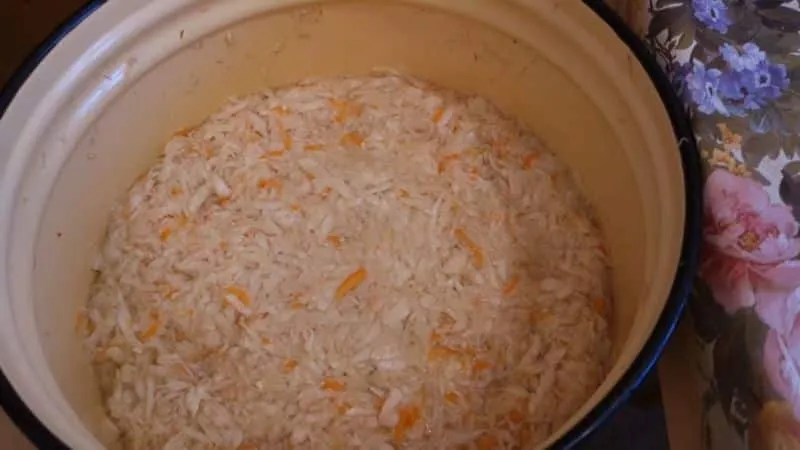
In the past, cabbage was fermented in wooden barrels, but today, home cooks use pots, buckets, or jars. Many households have cookware made of aluminium, steel, or cast iron.
When selecting a container for salting cabbage, consider the following:
- Vegetables darken when in contact with metal.
- Alkali and acid from the brine react with aluminium, worsening the taste of the final product – a metallic aftertaste may develop.
Can you ferment in an enamel pot? Many people use it for years. The enamel coating must be intact, without chips or cracks, to prevent acid from reacting with the metal. Aluminium cookware is often made from alloys mixed with zinc or beryllium. During chemical reactions, these can release compounds harmful to health, leading to poisoning and digestive issues.
Selecting and Preparing the Main Ingredient
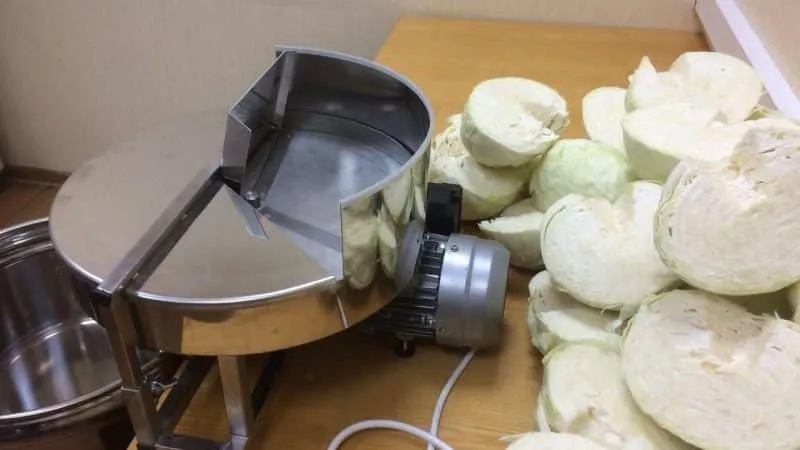
Winter cabbage varieties with dense leaf structures are best for salting. These retain their texture longer and don’t turn mushy during fermentation.
The leaves should be juicy, white, free from dark spots, cracks, or signs of rot.
The larger the head, the better the salted cabbage will taste. It’s preferable to shred half or a quarter of a large head rather than two small ones.
Before use, rinse the cabbage and remove the outer leaves. For shredding, a mandoline with one or two sharp blades is ideal. If unavailable, a vegetable peeler or grater will work. Manual or electric slicers can also simplify the process.
The photos below show different vegetable shredding tools.
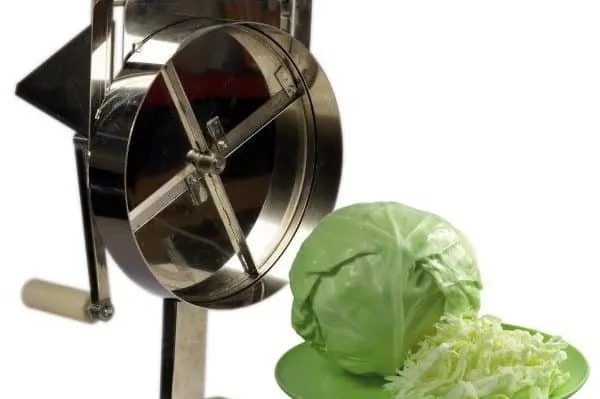
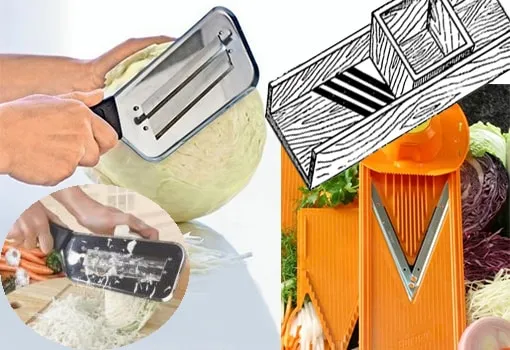
Classic Salting Method
The traditional recipe uses three ingredients:
- White cabbage – 1 kg;
- Large carrot – 1 pc.;
- Salt – 25 g.
Preparation:
- Mix shredded cabbage with grated carrots and salt in a deep plastic or enamel bowl. Massage the vegetables with your hands.
- Transfer the mixture to a clean container, press down with a wooden board or plate, and place a weight (e.g., a jar filled with water) on top.
- Leave the pot at room temperature for 4-6 days. Once fermented, transfer the cabbage to glass jars.
Recipe Variations
The classic recipe has many variations. Vegetables can be mixed with cranberries, apples, caraway seeds, beetroot, bay leaves, horseradish, sugar, or honey.
Salting Young Cabbage
Young cabbage, with its tender leaves, is often used in summer salads. However, it’s also great for quick pickling. Here’s a fast recipe for large-chunk salted cabbage.
Ingredients:
- Young cabbage – 2 kg;
- Carrots – 2 pcs.;
- Salt – 50 g;
- Sugar – 25 g.
Preparation:
- Grate the carrots and cut the cabbage into large chunks.
- Combine the vegetables in a deep bowl, add sugar and salt, and massage with your hands.
- Transfer the mixture to a pot, place a weight on top, and leave for 1-2 days.
With Carrots and Sugar
Sugar in this recipe speeds up fermentation. The salting process takes no more than 2 days.
Ingredients:
- White cabbage – 2.5 kg;
- Carrots – 3 pcs.;
- Salt – 60 g;
- Sugar – 40 g;
- Water – 3 l.
Preparation:
- Massage shredded cabbage and grated carrots with your hands until juice appears, then transfer to a pot.
- Boil water with salt and sugar until dissolved.
- Pour the cooled brine over the vegetables, cover with cabbage leaves, and place a weight on top.
With Apples
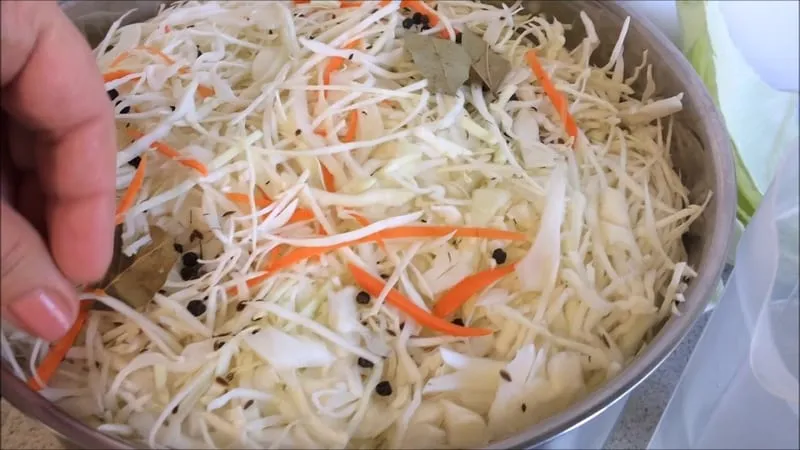
Apples add a pleasant sweetness to this recipe.
Ingredients:
- White cabbage – 2 kg;
- Apples – 6 pcs.;
- Salt – 50 g;
- Sugar – 30 g;
- Bay leaves – 3 pcs.;
- Black and allspice – to taste;
- Carrots – 2 pcs.
Preparation:
- Wash the apples, remove the cores, and cut into small pieces.
- Shred the cabbage, grate the carrots, add sugar and salt, and massage with your hands.
- Layer the apples and vegetables in a pot, sprinkling with spices. Place a weight on top and leave in a warm place for a week.
With Cranberries
The tart berries add a tangy note. Cranberries can be replaced with lingonberries, rowanberries, or viburnum.
Ingredients:
- Cabbage – 3 kg;
- Carrots – 2 pcs.;
- Salt – 60 g;
- Cranberries – 150 g.
Preparation:
- Mix shredded vegetables with salt and massage until juice appears.
- Add cranberries, mix well, and transfer to a pot.
- Place a plate on top and weigh it down with a jar of water.
With Caraway Seeds
The aromatic spice enhances the dish with its slightly bitter, peppery flavour.
Ingredients:
- White cabbage – 2 kg;
- Carrots – 1 pc.;
- Salt – 50 g;
- Caraway seeds – 50 g.
Preparation:
- Mix shredded cabbage with grated carrots and salt, then massage until juicy.
- Combine with caraway seeds and transfer to a pot.
- Place a plate on top and weigh it down.
With Beetroot
Beetroot gives the cabbage a pleasant pink hue, making the dish visually appealing.
Ingredients:
- Cabbage – 3 kg;
- Beetroot – 2 pcs.;
- Carrots – 2 pcs.;
- Water – 3 l;
- Salt – 80 g;
- Garlic – 2 cloves;
- Sugar – 40 g;
- Dill sprigs – to taste.
Preparation:
- Mix shredded cabbage with grated beetroot and carrots, then massage until juicy.
- Press the garlic and add to the vegetables.
- Place dill sprigs at the bottom of the pot, then pack the vegetable mixture tightly.
- Prepare a hot brine with salt and sugar, pour over the vegetables, and place a weight on top. Leave in a warm place for 12 hours. Pierce the mixture daily with a wooden skewer to release carbon dioxide.
With Horseradish
This recipe is perfect for lovers of spicy food. The horseradish root adds crunch and aroma.
Ingredients:
- Cabbage – 2.5 kg;
- Carrots – 2 pcs.;
- Horseradish root – 1 pc.;
- Garlic – 1 head;
- Water – 3.5 l;
- Salt – 60 g;
- Sugar – 100 g;
- Black peppercorns – to taste.
Preparation:
- Combine shredded vegetables in a deep bowl.
- Grate the horseradish root and add to the vegetables. Massage until juicy.
- Prepare a brine with water, salt, sugar, and pepper, then pour over the vegetables.
- Place a weight on top. The cabbage will be ready in 10-12 hours.
With Garlic
This variation has a subtle garlic aroma and a tangy taste.
Note. Avoid iodised salt – it softens the vegetables, making them slippery and unappetising.
Ingredients:
- Cabbage – 1 kg;
- Carrots – 1 pc.;
- Sunflower oil – 100 ml;
- Sugar – 15 g;
- Salt – 25 g;
- Apple cider vinegar – 50 ml;
- Water – 0.5 l;
- Garlic – 2 cloves.
Preparation:
- Mix shredded vegetables with pressed garlic.
- Prepare a brine with water, sugar, salt, and oil, then stir in the vinegar.
- Pour the boiling liquid over the vegetables and place a weight on top. The dish will be ready in 5-6 hours.
With Honey
This recipe dates back generations. Honey replaces sugar in the brine.
Ingredients:
- White cabbage – 3 kg;
- Carrots – 3 pcs.;
- Water – 1 l;
- Salt – 60 g;
- Honey – 2 tbsp.
Preparation:
- Shred the cabbage and carrots, then massage with your hands. Transfer to a pot.
- Boil water with salt, then cool to +40°C and dissolve the honey in it.
- Pour the brine over the vegetables and place a weight on top. Leave for 5-6 days.
Storage Tips for Salted Cabbage
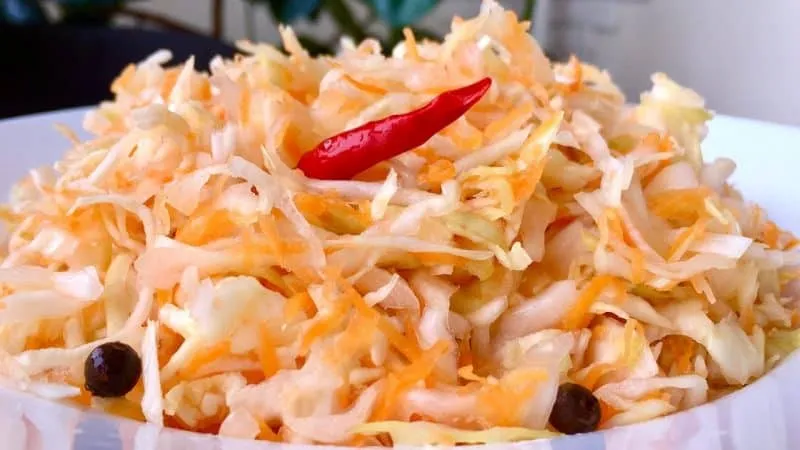
Salted cabbage stays crisp and mould-free, and the brine remains clear when stored at +1…+5°C with 80-90% humidity. Under these conditions, it lasts 6-8 months.
At temperatures above +5°C, fermentation continues, altering the taste.
Transfer the salted cabbage to clean glass jars and refrigerate (if space allows), store on a glazed balcony, or in a cellar. Alternatively, portion it into freezer bags and freeze. The texture and flavour remain unchanged.
Tips from Experienced Cooks
To ensure long-lasting, high-quality salted cabbage, follow these recommendations:
- Use dense, round heads – they’re juicier than flat ones.
- Slightly frostbitten cabbage ferments best, as it contains more natural sugars.
- For quick salting, use hot brine.
- Sugar softens the leaves, so avoid over-fermenting.
- Cut cabbage in various ways: chunks, thick or thin strips. Larger pieces take longer to ferment and work best with hot brine.
- Keep the cabbage submerged in brine to prevent discolouration.
- Remove any darkened top layer and mix the vegetables from bottom to top.
- Store the finished product in glass jars in a cool place.
- Opt for clay or glass containers instead of enamel pots.
- Place bay leaves and herb sprigs at the bottom of the container.
Conclusion
Salted cabbage, prepared with dry salting, is a classic recipe in many European countries. However, in the past, salt wasn’t used – instead, fermented cabbage with berries and water was the norm.
Over time, recipes evolved. Today, salted cabbage includes sugar, vinegar (apple or white), bay leaves, and spices. Instead of wooden barrels, enamel, glass, or clay pots are now preferred.







